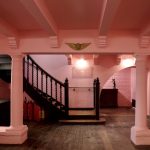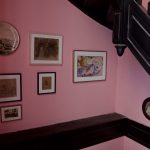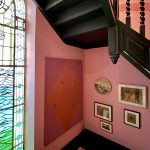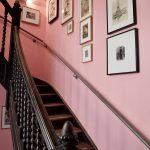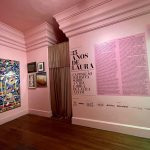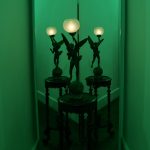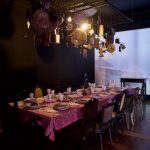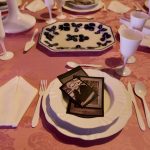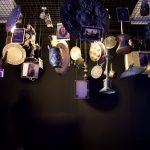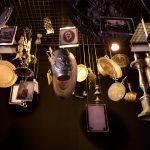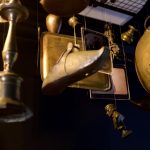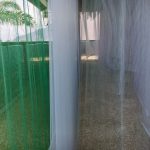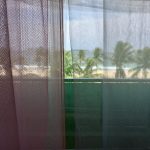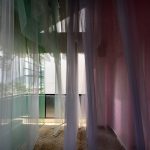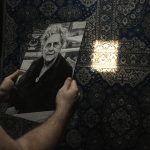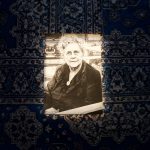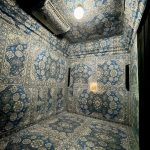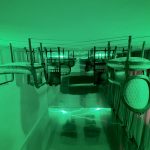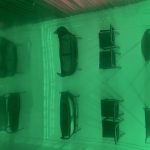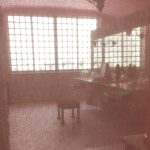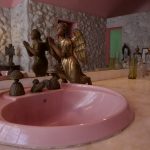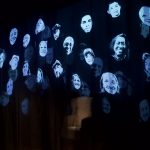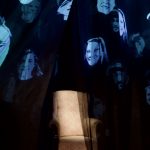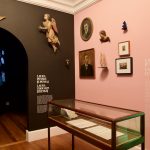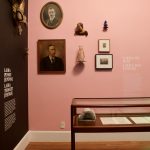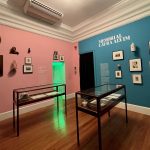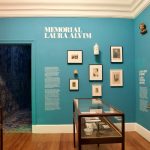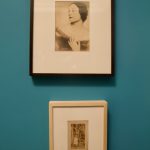POR UM TETO TODO NOSSO
FOR A CEILING OF OUR OWN
Circuito instalativo criado para exposição "35 Anos de Laura"
28 SET – 13 NOV, 2022
Visitação à instalação:
de quarta a quinta das 13h às 20h
e de sexta a domingo 13h às 18h
CENTRO DE CULTURA LAURA ALVIM (CCLA)
AV VIEIRA SOUTO, 176, IPANEMA
RIO DE JANEIRO / RJ
English below
Por Ana Roman
Em 1971, Linda Nochlin escreve um texto intitulado “Por que não houve grandes artistas mulheres?’’. Nele, a autora nos coloca diante dos limites relacionados à autoria e à estrutura social que dificultam a inserção das mulheres no campo artístico. Em discursos recorrentes no senso comum, e apoiados em expectativas quanto à sensibilidade e ao que seria identificado com uma dada feminilidade, a dificuldade de inserção de mulheres no campo artístico teria relação com as especificidades dashabilidades de mulheres, que não seriam reconhecidas pela sociedade enquanto excepcionais. A autora nos alerta do perigo deste tipo de análise, pois nossa pergunta é apenas a ponta de um iceberg queenvolve a reprodução da desigualdade na sociedade e do lugar nela ocupado pela mulher.
Ao nos aproximarmos da história de Laura Alvim, uma e outra vez, ouvimos sobre sua beleza, seu desejo e sobre dificuldade de ser atriz no contexto social no qual se inseria. Sua biografia é, constantemente, unida às histórias de seus importantes familiares – pai e avô – que, à sua maneira revolucionaram campos de conhecimento e fizeram propagar críticas ao estado das coisas. Laura é vista como uma mulher excêntrica,frustrada por não ser atriz, que causa paixões por onde circula e que, após problemas de pele, se confina dentro desta casa. Nesta comum narrativa, ela parece, muitas vezes, esmorecida diante da dificuldade e impossibilidade de inserção no sistema artístico.
Ao olharmos para o espaço que nos cerca e que, há mais de 35 anos, resiste como um espaço de cultura na cidade do Rio de Janeiro,nos perguntamos: não seria necessário contarmos outra narrativa? Por que contar a história de uma mulher a partir da história dos homens que a cercam? Não seria Laura Alvim apenas uma mulher com um grande desejo de construir uma sociedade no qual a arte e a cultura teriam outro espaço? Não seria Laura Alvim uma mulher que lutou, até o fim da sua vida, para construir um espaço de experiência e acolhimento para o setor artístico dentro de sua própria casa? Não seria ela, com toda agência que caberia em alguém de sua classe e contexto, que abriu mão e suspendeu as expectativas sociais apriorísticas em torno de si e que, de certa forma, nos disse: não deve haver limites para ficção, imaginação e o desejo de transformação da sociedade? Laura lutou. Ela foi também uma mulher.
No circuito instalativo desta exposição, Laura Alvim e o espaço cultural em si são tratados a partir dos diversos ‘também’ que os compõem: Laura foi também mulher, também do teatro, também filha de importante cientista, também visionária, também muito preocupada com os migrantes (…); a Casa de Cultura é também um espaço do audiovisual, também já foi palco para importantes festivais de música e de teatro, também já abrigou exposições de grandes artistas (….). O ‘também’ se reflete na própria arquitetura do espaço: não há um único estilo, e a sobreposição de tempos no espaço é clara ao visitante atento.
Para o projeto “35 Anos de Laura”, o coletivo-comunidade Uncool Artist trabalhou por seis meses, em intensa colaboração, no desenvolvimento poético do circuito imersivo instalado na Casa de Cultura. A proposta do trabalho (concebida por Carolina Paz, Danié Gomez-Ortigoza, Diogo Montes, Guto Nunes, Liene Bosquê, Marina Quintanilha, Mariana Battistelli e Valincy-Jean Patelli) consistiu na suspensão de uma ideia de autoria individual: as instalações funcionam como cenas em peças de teatro nas quais conseguimos identificar atos performáticos e assinaturas, que, imediatamente, se dissolvem em nome de uma cena na qual o protagonismo é compartilhado, inclusive pelo público visitante-espectador-autor. Não há dentro e nem fora, os espelhos constroem um espaço entre ao qual todos são convidados, junto à cidade, a participar.
Nosso pressuposto é de que não é possível revisitar e ficcionalizar a história de qualquer mulher sem considerar a dimensão da produção e reprodução coletiva. A Casa de Cultura Laura Alvim foi um projeto que se construiu por uma crença compartilhada acerca da necessidade de se construir um outro mundo. As coisas animadas, os reflexos, as memórias fragmentadas, os móveis deslocados e objetos do acervo da casa que compõem as várias instalações da mostra são guardiões, alimento, dispositivos de imersão para a construção de outras ficções. O convite da mostra é de que repensemos a nossa percepção do mundo e habitemos o “também”, deixando de lado o binarismo e polarização que marcam nossa experiência contemporânea, e de que possamos construir uma outra sociedade, na qual as instituições culturais e artísticas tenham cada vez maior centralidade.
By Ana Roman
In 1971, Linda Nochlin wrote a text entitled “Why Have There Been No Great Women Artists?”. In it, the author confronts us with the limits related to authorship and the social structure that make it difficult for women to enter the artistic field. In common sense discourses supported by expectations regarding sensitivity and what would be identified with certain femininity, the difficulty of inserting women into the artistic field would be related to the specificities of women’s abilities, which society would not recognize as exceptional. The author warns us of the danger of this type of analysis, as our question is just the tip of an iceberg that involves the reproduction of inequality in society and the place women occupy in it.
As we approach Laura Alvim’s story, once and again, we hear about her beauty, her desire, and the difficulty of being an actress in the social context in which she was inserted. Her biography is constantly linked to the stories of her important family members – father and grandfather – who, in their own way, revolutionized their fields of knowledge and propagated criticism of the status quo. Laura is seen as an eccentric woman, frustrated by not being an actress, the cause of passion wherever she goes, and who, after skin problems, confines herself inside this house. In this standard narrative, she often seems weakened by the difficulty and the impossibility of entering the artistic establishment.
When we look at the space that surrounds us and that, for more than 35 years, has resisted as a space of culture in the city of Rio de Janeiro, we ask ourselves: shouldn’t we tell another story? Why tell a woman’s story from the stories of the men around her? Was Laura Alvim not just a woman with a great desire to build a society where arts and culture would have another space? Was Laura Alvim not a woman who fought, until the end of her life, to build a space of experience and reception for the artistic sector inside her own home? Was she not someone who, with the agency bestowed upon her by her class and context, gave up and suspended the a priori social expectations around her and who, in a way, told us: there should be no limits to fiction, imagination, and the desire to transform society? Laura struggled. She was also a woman.
In the installation circuit of this exhibition, Laura Alvim and the cultural center itself are treated from the different ‘alsos’ that compose them: Laura was also a woman, also from the theater, also the daughter of an important scientist, also a visionary, also very concerned with migrants (…); the cultural center is also an audiovisual space, it has also been the stage for important music and theater festivals, it has also hosted exhibitions by great artists (…). The ‘also’ is reflected in the architecture of the space itself: there is no singular style. The overlapping of times in space is clear to the attentive visitor.
For the project “35 Years of Laura”, the collective-community Uncool Artist worked for six months, in intense collaboration, on the poetic development of the immersive circuit installed at the Casa de Cultura. The proposal (created by Carolina Paz, Danié Gomez-Ortigoza, Diogo Montes, Guto Nunes, Liene Bosquê, Marina Quintanilha, Mariana Battistelli e Valincy-Jean Patelli) consisted of the suspension of an idea of individual authorship: the installations work as scenes in theater plays in which we can identify performative acts and signatures, which, immediately, dissolve in the name of a scene in which the protagonism is shared, including the visitor-spectator-author. There is no inside nor outside, the mirrors build an in-between space, where everyone is invited, together with the city, to participate.
Our assumption is that it is impossible to revisit and fictionalize the history of any woman without considering the dimension of collective production and reproduction. Casa de Cultura Laura Alvim was a project that was built out of a shared belief about the need to create another world. The animated things, the reflections, the fragmented memories, the displaced furniture, and objects from the house’s collection that make up various installations in the exhibit are guardians, food, and immersion devices for constructing other fictions. The exhibition invites us to rethink our perception of the world and inhabit the “also”, leaving aside the binarism and polarization that mark our contemporary world, and that we can build another society, in which cultural and artistic institutions have increasing centrality.
- 01
- 02
- 03
- 04
- 05
- 06
- 07
- 08
- 09
- 10
A parede rosa demarca a coluna vertebral dessa casa-corpo e anuncia seu interior. Interior-casa. Interior-corpo. Casa-corpo-mulher. Nas paredes, a somatória das coletas afetivas de Laura, de seu pai, de sua família, de seus amigos artistas. Polifonia e fragmentos cuja origem exata não interessa. Quadros, obras, figuras e objetos do acervo de Laura, dispostos lado a lado, remontam às primeiras galerias do século XIX — também chamadas de passagens —, criadas para modificar as relações entre público e privado no espaço urbano das cidades. Nestas passagens, criadas para exposição, sugerem-se outras relações entre o público e a casa, e estimulam-se distintas percepções acerca da importância deste lugar na história carioca e brasileira. Laura Alvim cultivou portas sempre abertas para a cultura. Por ali passaram personalidades celebradas em sua época, assim como diversos novos artistas apoiados por esta grande benemérita, que desejou transformar sua casa em um centro cultural. Esta coluna- galeria criada nas escadarias homenageia todos que ali passaram e ajudaram a tornar este espaço um pilar criativo.
The pink wall demarcates the spine of this house-body and announces its interior. Interior-house. Interior-body. House-body-woman. On the walls, the sum of the affective collections of Laura, her father, her family, her friends, and artists. Polyphony and fragments whose exact origin do not matter. Paintings, works, figures, and objects from Laura’s collection, arranged side by side, date back to the first galleries of the 19th century – also called “passages” -, created to modify the relationship between public and private in the urban space of cities. In these “passages”, created for the exhibition, other relationships between the public and the house are suggested, and different perceptions are encouraged about the importance of this place in the history of Rio de Janeiro and Brazil. Laura Alvim always kept doors open to culture. Through her house passed personalities celebrated in her time, as well as several new artists supported by this great benefactor, who wanted to transform her home into a cultural center. This column-gallery created on the stairs honors everyone who passed by and helped make this space a creative pillar.

Uma parede de espelhos, ao fundo do corredor, cria um labirinto. Constroem-se novos percursos e lugares entre os ambientes da casa. Ao centro desta instalação está disposta uma mesa de apoio com uma luminária de anjo. Sua luz acesa nos guia, com segurança, por este labirinto de mistérios. A Casa de Cultura Laura Alvim é um espaço camaleônico em Ipanema. Sua história é marcada por constantes transformações, enunciadas pela linha do tempo que recebe os visitantes na casa. A imagem do labirinto confunde-nos e, ao mesmo tempo, abre possibilidade para um mundo pouco explorado no universo da casa e de Laura Alvim.
A wall of mirrors at the end of the corridor creates a labyrinth. New routes and places are built between the rooms of the house. At the center of this installation, there is a side table with an angel lamp. Its light guides us, safely, through this labyrinth of mysteries. Casa de Cultura Laura Alvim is a chameleon-like space in Ipanema. Its history is marked by constant transformations, enunciated by the timeline that welcomes visitors to the house. The image of the labyrinth that rises before our eyes confuses us and, at the same time, opens the possibility for a little- explored world in the universe of the house and Laura Alvim.
No terceiro andar, o visitante se depara com uma projeção que ocupa uma das paredes do cômodo, atravessada por um aparador. A projeção traz a paisagem de fora para dentro e, como uma larga janela, com vista privilegiada, conduz o olhar do visitante para uma mesa posta. A mesa, com treze cadeiras, é elegante, presunçosamente europeia, mas quintessencialmente brasileira. Sobre a toalha rosa, em seu centro, repousa um candelabro cercado por utensílios tradicionais brancos. O visitante é servido de memórias: pratos e travessas repletos de fotos e documentos pessoais de Laura Alvim. Laura também está representada ali, na cadeira preta que referencia os trajes de luto adotados por ela após a morte do pai. Uma densa nuvem de objetos originais do acervo sobrevoa essa representação da mesa de jantar da família de forma poética, íntima, e de certa forma voyeurística. Presentificam-se pessoas e memórias nas cadeiras vazias. O foco não são os objetos ou fatos históricos representados, mas os sentimentos que esta coleção pode fazer emergir.
On the third floor, the visitor is faced with a projection that occupies an entire wall, crossed over by a sideboard. The projection brings the landscape from the outside in and, like a large window, with a privileged view, it leads the visitor’s gaze to a table set for a meal. The table, with thirteen chairs, is elegant, smugly European, yet quintessentially Brazilian. On the pink tablecloth, in its center, rests a chandelier surrounded by traditional white utensils. The visitor is served with memories: plates and platters full of photos and personal documents of Laura Alvim. Laura is also represented there, in the black chair that references the mourning clothes adopted after her father’s death. A dense cloud of original objects from the collection flies over this representation of the family’s dining table in a poetic, intimate, and somewhat voyeuristic way. People and memories are present in the empty chairs. The focus is not on the objects or historical facts represented, but on the feelings that this collection can bring out.

Neste ambiente, propõe-se uma experiência sensorial: caminhar entre camadas de tecidos esvoaçantes pendurados pelo teto. Os tecidos fazem um degradê do rosa para o azul, conectando o interior e o exterior da casa. Com todo o piso da varanda coberto de areia, o visitante é convidado a tirar os sapatos, absorvendo e filtrando as energias ali existentes, e a sentir os tecidos e encontrar o caminho até o mar. Ouvem-se os sons típicos do cotidiano da praia por meio de um sistema de som distribuído no ambiente. Desloca-se a praia para a varanda e cria-se um metaverso dentro do reflexo do espelho. A Casa Laura Alvim passou por reestruturação e várias reformas. Cada camada de construção narra essa história que reflete sua importância não só na casa, mas na cidade do Rio.
In this room, a sensorial experience is proposed: to walk through the layers of flying fabric hanging from the ceiling. The fabrics fade from pink to blue, connecting the interior and exterior of the house. With the floor covered in sand, the visitor is invited to take off his shoes, absorbing and filtering the energies present there, to feel the fabrics, and to find a way to the sea. The typical sounds of everyday life on the beach can be heard through a sound system distributed in the room. The beach is moved to the balcony and a metaverse is created within the reflection of the mirror. Casa Laura Alvim underwent restructuring and several renovations. Each layer of construction narrates this story that reflects its importance not only in the house itself but also in the city of Rio.
Chão e teto são, nesta sala, cobertos por tapetes. Ouvimos vozes, passos, sussurros. Estaria Laura ensaiando para uma peca? Laura, amante do teatro e da música, poderia ter se tornado pianista e seguido a carreira de atriz. Sonhos não realizados por oposição familiar e preconceitos da época. Laura falava francês fluente e atuava, na intimidade, para amigos em seu pequeno palco doméstico. Imagine que aqui você escuta Laura, atriz e personagem de si mesma. O trecho recitado é poema da obra de “Le Malade” de Marguerite de Navarre, farsa escrita em 1535-1536, cuja história narra tentativas de cura de um doente por meio da medicina e da fé.
Dieu, voyant que sa créature/ Sans maladie ne peut vivre/ Nous fist aÿde de Nature/ Par qui de mal est délivre
Tradução para o português:
Deus, vendo que sua criatura/ Sem doença não pode viver/ Nos fez ajudar a Natureza/ Para quem do mal é livrada
Texto nosso:
Dieu et maladie/ Dieu est maladie/ Dieu sans maladie/ Je suis la nature papa!/ Pour tourjours la nature papa./ Tu me manque papa./ Où es-tu papa?/ Je suis la nature!/ Nous sommes tous la nature papa!/ Pour tourjours la nature papa.
Tradução para o português:
Deus e doença/ Deus é doença/ Deus sem doença/ Eu sou a natureza papai!/ Para sempre natureza papai./ Sinto sua falta papai./ Onde está você papai?/ Eu sou a natureza!/ Somos todos natureza papai!/ Para sempre natureza papai.
Da fortuna à miséria, da beleza à reclusão devido a uma doença de pele, nada disso foi capaz de impedir Laura de transformar a casa em um centro cultural e em homenagem a seu falecido pai. Neste espaço mergulhamos em seu universo íntimo. Hoje, ela nos visita e contempla seu legado.
Sobre a foto da mulher que nos olha enquanto ouvimos a peça sonora neste ambiente, descobriu-se, após aberta à visitação, de que aquela não era Laura Alvim, a fundadora do centro cultural, mas sua mãe, que também se chamava Laura. Tem-se pouca informação sobre a “Laura-mãe” e era nosso desejo deixar essa imagem destacada na obra, mesmo não sendo a mulher que imaginávamos a priori. Porém, a pedido da direção geral do projeto fomos provocados a repensar nossa criação e chegamos à única decisão que nos parecia a menos disruptiva: a retirada da imagem tratando assim de uma (ou várias) ausência(s) –– afinal Laura Alvim não se deixou fotografar quando idosa. Essa se tornou em vários níveis uma peça sobre perdas, ausências e luto.
The floor and ceiling are, in this room, covered by rugs. We hear voices, footsteps, and whispers. Would Laura be rehearsing for a play? Laura, a lover of theater and music, could have become a pianist and followed a career as an actress. Dreams that remained unfulfilled due to family opposition and the prejudices of the time. Laura was fluent in French and performed to friends on her little stage at home. Imagine that you listen to Laura as an actress and a character of herself. The passage recited is a poem from the “Le Malade” by Marguerite de Navarre, a farce written in 1535-1536 whose story narrates attempts to cure a sick man through medicine and faith.
Dieu, voyant que sa créature/ Sans maladie ne peut vivre/ Nous fist aÿde de Nature/ Par qui de mal est délivre
English translation:
God, seeing that his creature/ Without disease, cannot live/ Made us help Nature/ For whom from evil is saved
Our text:
Dieu et maladie/ Dieu est maladie/ Dieu sans maladie/ Je suis la nature papa!/ Pour tourjours la nature papa./ Tu me manque papa./ Où es-tu papa?/ Je suis la nature!/ Nous sommes tous la nature papa!/ Pour tourjours la nature papa.
English translation:
God and disease/ God is disease/ God without disease/ I am nature daddy!/ Forever nature daddy./ I miss you daddy./ Where are you daddy?/ I am nature!/ We are all nature daddy!/ Forever nature daddy.
From fortune to misery, from beauty to seclusion due to a skin disease, none of this could stop her from realizing her dream. In this space, we dive into her intimate universe. Today, she visits us and contemplates her legacy.
About the photo of the woman who looks at us while we listen to the sound piece in this space, it was found, after opening to visitors, that it was not Laura Alvim, the founder of the cultural center, but her mother, who was also called Laura. There is little information about the “Laura-mother,” and it was our wish to leave this image highlighted in the installation piece, even though she was not the woman we imagined a priori. However, at the request of the project’s general direction, they provoked us to rethink our creation, we came to the only decision that seemed to us the least disruptive: the removal of the image, thus dealing with one (or several) absence(s) –– after all, Laura Alvim was not let her photograph when she was old. This became, on many levels, a play about loss, absence, and grief.
No teto, dispõem-se cadeiras suspensas; na lateral direita, uma cortina reforça a sensação de um ambiente teatral, de um “palco íntimo”. Desse palco, logo à frente, um grande espelho cobre toda a parede e também o chão. O ambiente de apresentação pequeno e privado é agigantado, e o visitante torna-se espectador e elenco desta peça. Laura aqui realizou o seu sonho de ser atriz, utilizando este espaço para se apresentar a seus amigos e pessoas de seu círculo social em recitais em francês.
On the ceiling, hanging chairs are installed; on the right side, curtains reinforce the feeling of a theatrical ambiance, of “an intimate stage”. Just across from the curtains, a great mirror covers the whole wall and the floor. The small and private performance environment is enhanced, and the visitor becomes the audience and cast of this play. Here Laura fulfilled her dream of being an actress, using this space to perform recitals in French to her friends and people in her social circle.
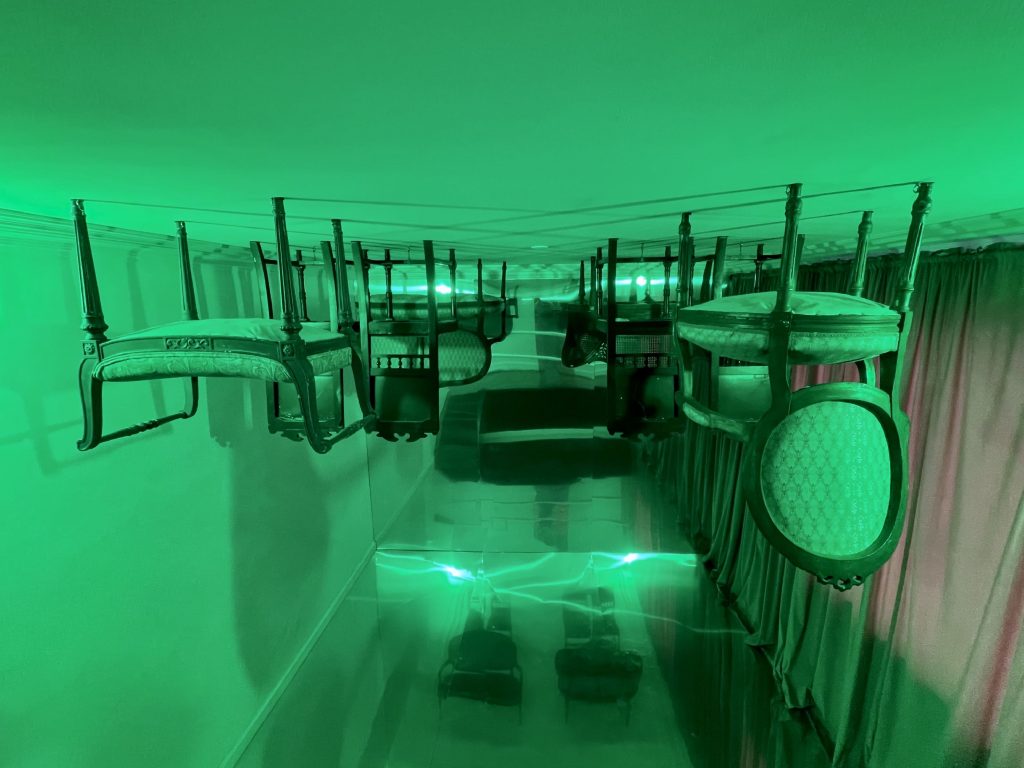
Um corredor de roupeiros é a entrada ao closet de Laura. O visitante encontra portas entreabertas, que guardam tranças de fita de cetim e sons com ruídos do passado.
Sala de banho e camarim, o cômodo cor-de-rosa é por si só um dos artefatos mais valiosos e singulares na casa. Coração de segredos e desejos íntimos daquela cujo gesto potente nos deixou esse lar que acolhe a cada artista (Bibi Ferreira, Ernesto Nazareth, Roberto Burle Marx, Álvaro Moreira, Rosalina Coelho Lisboa, Isadora Duncan, Fernanda Montenegro, Tônia Carrero, entre tantos outros).
Sem pudores. Todas as artes, sem julgamento, são aqui bem-vindas.
A hallway of wardrobes is the entrance to Laura’s closet. . The visitor finds half-open doors, behind which are satin ribbon-made braids and sounds with noises from the past.
Bathroom and dressing room, the pink room is in itself one of the most valuable and unique artifacts in the house. Heart of secrets and intimate desires of the one whose powerful action left us this home that welcomes each artist (Bibi Ferreira, Ernesto Nazareth, Roberto Burle Marx, Álvaro Moreira, Rosalina Coelho Lisboa, Isadora Duncan, Fernanda Montenegro, Tônia Carrero, among many others).
No shame. All arts, without judgment, are welcome here.
Em torno de uma poltrona iluminada, tecidos se movimentam e servem de superfície para projeções de rostos de pessoas da cidade do Rio de Janeiro. As camadas formadas pelos tecidos transparentes escuros e as projeções em branco referenciam o Raio-X, tecnologia trazida para o Brasil por Álvaro Alvim, pai de Laura, em 1897. Ele, por sua vez, é considerado um dos mártires da ciência no Brasil, pois teve sua saúde debilitada pelas experiências realizadas com esta tecnologia tão importante para o desenvolvimento da medicina. Esta sala representa, ao mesmo tempo, o legado deixado pela família Alvim para a cidade do Rio de Janeiro — a poltrona vazia simboliza a ausência — e a comunidade para quem essa exposição é ofertada.
Around an illuminated armchair, fabrics move and serve as a surface for projections of faces of people from the city of Rio de Janeiro. The layers formed by the dark transparent fabrics and the white projections refer to the X-Ray, a technology brought to Brazil by Álvaro Alvim, Laura’s father, in 1897. He is considered one of the “martyrs of science” in Brazil, as his health was weakened by the experiments carried out with this technology, so important for the development of medicine. This room represents, at the same time, the legacy left by the Alvim family for the city of Rio de Janeiro –– the empty armchair symbolizes absence –– and the carioca community to whom this exhibition is offered.

O que Laura foi, fez, pensou e quis. Mobiliário, documentos e peças de seu acervo íntimo, fotos e documentos inéditos estão disponíveis para o visitante conhecer e entrar em contato com a história deste espaço tão simbólico. Um ambiente de objetos subjetivados para conectar o público à história e a memória de Laura Alvim.
What Laura was, did, thought, and wanted. Furniture, documents, and pieces of her intimate collection, pictures, and unpublished documents are available for the visitor to get to know and get in touch with the history of this very symbolic space. An environment of subjectivized objects to connect the public to the history and memory of Laura Alvim.

O público da exposição, o morador do Rio de Janeiro e cada visitante da casa são co-autores de toda essa história e são por quem – e para quem – se dará continuidade no contar sobre Laura e sua casa-cultura. Um livro de colorir serve como repositório meditativo de lembranças, devaneios, relações entre formas e cores. Os objetos, rostos e lembranças impressos em suas páginas , ocos à espera de novas cores , estarão preservados na lembrança visual e na oralidade do compartilhar o que foi a experiência vivida.
The exhibition attendees, the resident of Rio de Janeiro, and each visitor to the house are co-authors of this whole story. It is by them – and for them – that the telling of Laura and her house-culture will be continued. A coloring book serves as a meditative repository of memories, daydreams, and relationships between shapes and colors. The objects, faces and memories printed on its pages, hollow waiting for new colors, will be preserved in the visual memory and in the oral nature of sharing the lived experience.
PDF para impressão/ Printable PDF
Percorra o circuito instalativo clicando nos números correspondentes acima
Go through the installation circuit by clicking on the corresponding numbers above
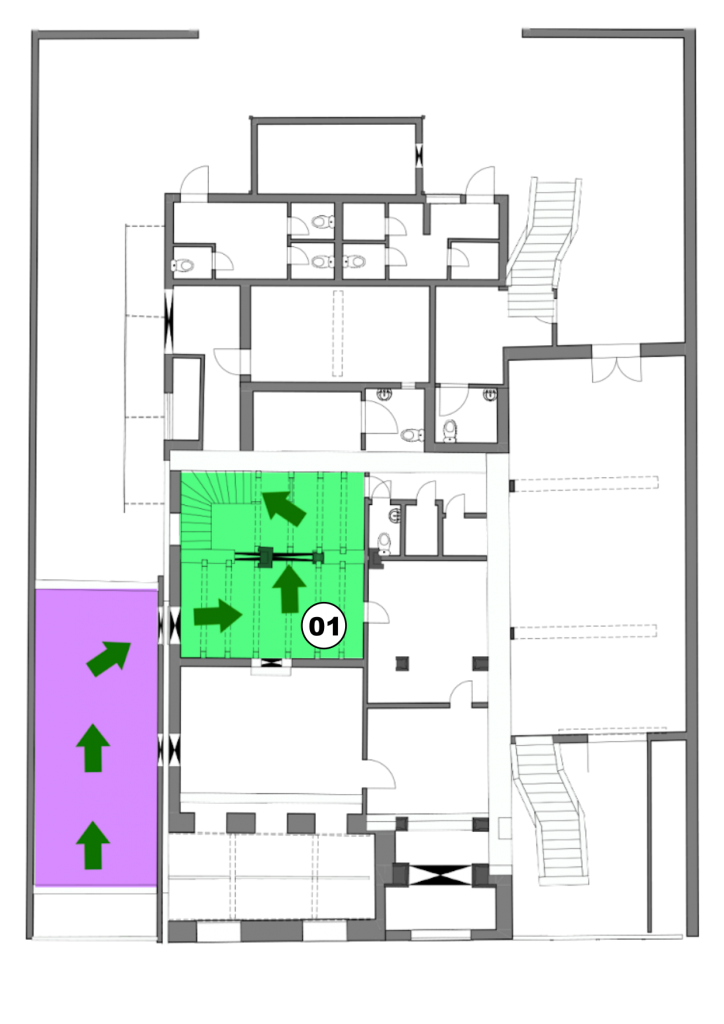
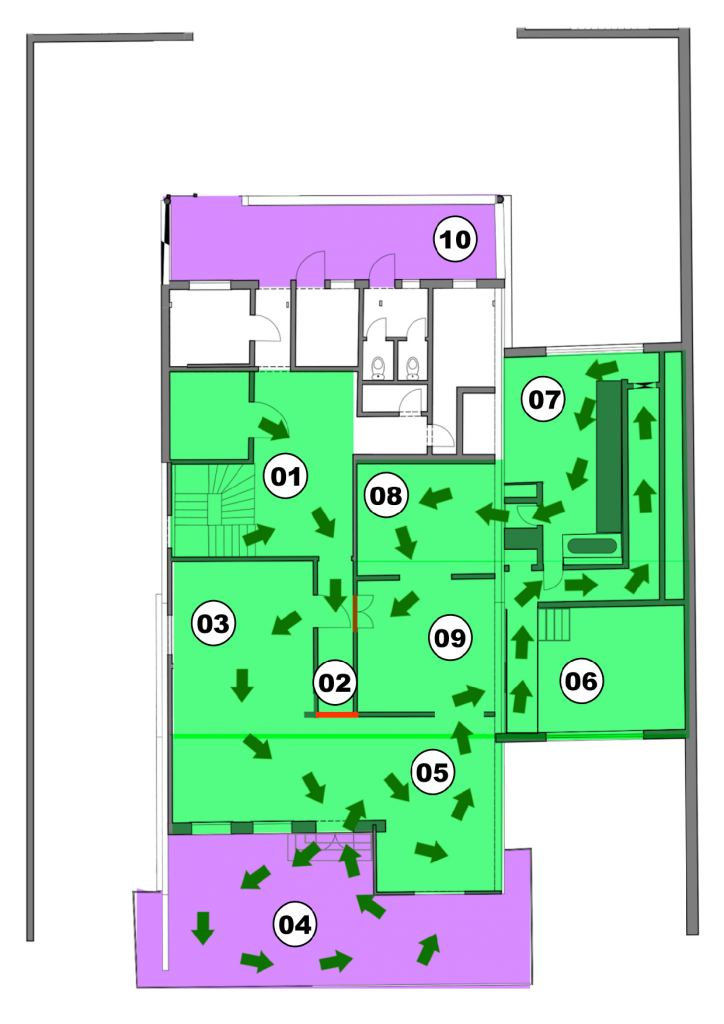
Uncool Artist
A Uncool Artist promove oportunidades de circulação, criação de vínculos que se expandem além dela mesma e apoio coletivo na gestão e execução de projetos. Somos uma comunidade –– composta por artistas, curadores, críticos e outros profissionais experientes e generosos –– que, ao longo dos últimos doze anos, vem se instaurando como um lugar singular para que artistas possam mergulhar profundamente em suas práticas, encontrar oportunidades únicas para mostrar suas criações, apresentar seus projetos e construir uma existência artística sustentável.
Nosso objetivo é produzir conhecimento crítico e criativo que busca empoderar subjetividades, criar novas comunidades e transformar estruturas sociais para serem mais inclusivas, abraçando a diversidade humana.
Uncool Artist promotes opportunities for circulation, for the creation of bonds that expand beyond itself, and for collective support of the management and execution of projects. We are a community –– made up of experienced and generous artists, curators, critics, and other professionals –– which, over the last twelve years, has established itself as a unique place for artists to deep dive into their practices, find unique opportunities to show their creations, present their projects and build in a sustainable artistic existence.
Our goal is to produce critical and creative knowledge that empowers subjectivities, creates new communities, and transforms social structures into more inclusive, embracing human diversity.
Somos [we are] UNCOOL ARTIST
Direção Artes Visuais
Carolina Paz
Texto Curatorial e Pesquisa
Ana Roman
Artistas
Danié Gomez-Ortigoza
Diogo Montes
Guto Nunes
Liene Bosquê
Marina Quintanilha
Mariana Battistelli
Valincy-Jean Patelli
Apoio produção artística
Carolina Lopes
Débora Rayel
Thais Ribeiro
Performer-vocal
Fernanda Baronne
Revisão e Tradução
Vítor Correia
Assessoria de Imprensa
Adriana Monteiro – Ofício das Letras
Idealização e direção geral “35 Anos de Laura”
Constelar – Tatianna Trinxet
Performance teatral
Direção
Daniel Herz
Atrizes
Carol Santaroni
Deise Manttuano
Raabe Roque
Roberta Brisson
Vêronica Reis
Figurinista
Ana Cecília
Cenografia e Cenotécnica
Marton Estúdio
Consultoria Técnica
Help Reforma e Construção
Desenho de luz
Fernanda Mantovani
Desenho de som
Gramophone Soluções
Equipamentos multimídia
Videomais soluções e tec audiovisuais
Equipe de Montagem
Lúcia Martinusso, Luis Albero “Betão”, Aldir Thomas, Leandro Lagostinho, Thiago Navas, Carlos Elias, Leandro Jacinto, Marcelo Muniz e Nelson Santana
Museóloga e Produtora Executiva
Rafaela Zanete
Equipe Museologia
Matheus Magalhães, Marcia Nascimento e Sabrina Nery
Monitores
Talita Dester, Matheus Magalhães, Pamela Monção, Pedro Mello e Nathalie Ferreira
Equipe Audioguia
Inclusive Acessibilidade
Equipe Interprete de Libras
JDL Acessibilidade
Assessoria de Imprensa
MNiemeyer
Branding e comunicação
Grupo Sal
Designer Gráfico
Bárbara Catta, Caterina Bloise e Victor Kenji
Willians Fabian e Letícia Andrade
Mídias digitais
Rippo
Imagens
Marcio Amaro
Digitalização Acervo
Luz e Sombra Serviços de Comunicação
Coordenação administrativa
Adriana Lemos
Coordenação de produção Fernanda Nicolis
Assistente de produção
Juliana Costa e Bruno Serrano
Assessoria Contabil
Gardi Contabil
Assessoria Jurídica
Felsberg Advogado
Gestão Administrativa Financeira
Cavalo Marinho
Realização
Constelar – Arte, Diversão e Cultura


- Brooklyn, NY - USA





